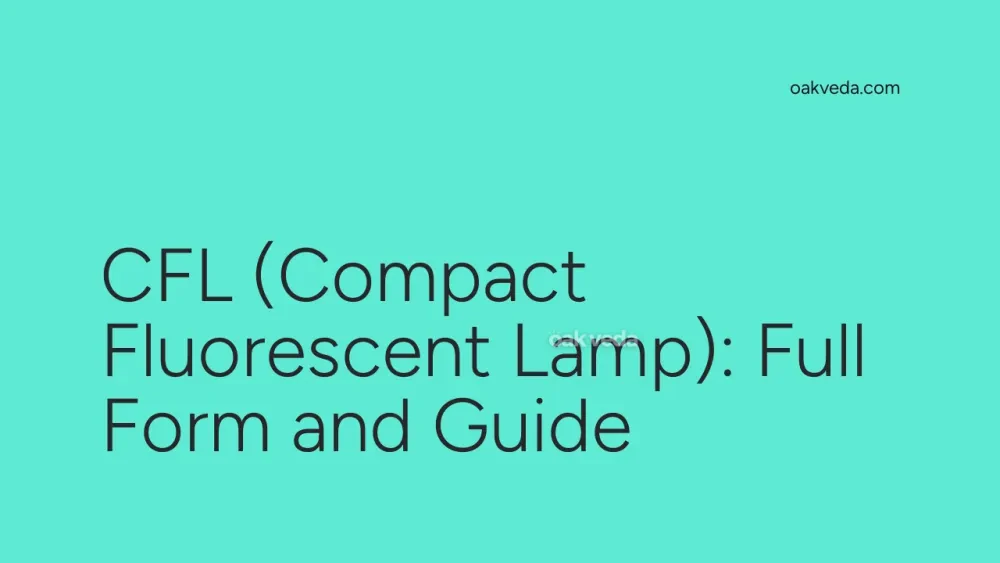
What is the Full Form of CFL?
The full form of CFL is Compact Fluorescent Lamp. This energy-efficient lighting solution has revolutionized the way we illuminate our homes and businesses, offering significant advantages over traditional incandescent bulbs.
What is a Compact Fluorescent Lamp?
A Compact Fluorescent Lamp, commonly known as CFL, is an energy-saving light bulb designed to replace conventional incandescent lamps. CFLs consist of a glass tube containing a mixture of argon gas and mercury vapor, with the inner surface coated with phosphorus. This unique design allows CFLs to produce light more efficiently than their incandescent counterparts.
Origin and Development of Compact Fluorescent Lamps
The history of CFLs dates back to the late 19th century:
- 1890s: Peter Cooper Hewitt invented the first fluorescent lamp, laying the groundwork for CFL technology.
- 1939: CFLs were redesigned to make them more affordable and practical for widespread use.
- 1976: Further improvements in CFL technology led to increased efficiency and reduced costs.
- 1980s-1990s: CFLs gained popularity as energy conservation became a global concern.
- 2000s-present: Continuous advancements have made CFLs more efficient, affordable, and widely adopted.
How does a Compact Fluorescent Lamp work?
The working principle of a CFL differs significantly from that of an incandescent bulb:
- Electrical current: When the lamp is switched on, an electric current flows through the tube.
- Mercury activation: The current excites the mercury vapor within the tube.
- UV light production: Excited mercury atoms emit ultraviolet (UV) light.
- Phosphor conversion: The UV light strikes the phosphor coating on the inner surface of the tube.
- Visible light emission: The phosphor coating converts UV light into visible light, illuminating the surrounding area.
This process is much more energy-efficient than the heat-based light production of incandescent bulbs.
Types of Compact Fluorescent Lamps
CFLs come in various types to suit different lighting needs:
- Spiral CFLs: The most common type, featuring a twisted tube design.
- Triple tube CFLs: Offer higher light output in a compact size.
- Circline CFLs: Circular-shaped lamps often used in ceiling fixtures.
- U-shaped CFLs: Designed for specific fixtures and applications.
- Dimmable CFLs: Compatible with dimmer switches for adjustable lighting.
Functions of Compact Fluorescent Lamps
CFLs serve several important functions in modern lighting:
- Energy-efficient illumination: Providing bright light while consuming less energy.
- Long-term cost savings: Reducing electricity bills and replacement frequency.
- Environmental protection: Lowering carbon emissions through reduced energy consumption.
- Versatile lighting solutions: Offering various color temperatures and brightness levels.
- Heat reduction: Generating less heat compared to incandescent bulbs.
Applications of Compact Fluorescent Lamps
CFLs find use in a wide range of settings:
- Residential lighting: Table lamps, ceiling fixtures, and outdoor lighting.
- Commercial spaces: Offices, retail stores, and restaurants.
- Industrial environments: Warehouses, factories, and production facilities.
- Institutional buildings: Schools, hospitals, and government facilities.
- Outdoor lighting: Street lamps, parking lots, and security lighting.
Features of Compact Fluorescent Lamps
Key features that make CFLs popular include:
- Energy efficiency: Using 60-80% less energy than incandescent bulbs.
- Long lifespan: Lasting up to 10 times longer than traditional bulbs.
- Variety of sizes and shapes: Fitting various fixtures and design preferences.
- Color options: Available in warm, cool, and daylight color temperatures.
- Quick start-up: Providing near-instant illumination upon switching on.
Benefits of Compact Fluorescent Lamps
CFLs offer numerous advantages:
- Reduced energy consumption: Lowering electricity bills significantly.
- Extended lifespan: Requiring less frequent replacements.
- Lower environmental impact: Reducing carbon footprint and energy demand.
- Versatility: Suitable for various lighting applications and fixtures.
- Cool operation: Generating less heat, improving comfort and safety.
- Cost-effectiveness: Providing long-term savings despite higher initial cost.
Limitations or Challenges of Compact Fluorescent Lamps
Despite their benefits, CFLs face some challenges:
- Mercury content: Requiring special disposal procedures.
- Initial cost: Higher upfront price compared to incandescent bulbs.
- Light quality: Some users find CFL light less appealing than incandescent.
- Warm-up time: Certain CFLs may take a moment to reach full brightness.
- Sensitivity to temperature: Performance can be affected by extreme cold or heat.
- Compatibility issues: Not all CFLs work with dimmer switches or enclosed fixtures.
Future Developments in Compact Fluorescent Lamp Technology
While LED technology is increasingly popular, CFL innovation continues:
- Improved efficiency: Ongoing research to enhance energy savings.
- Reduced mercury content: Developing CFLs with minimal environmental impact.
- Better color rendering: Improving light quality to match natural daylight.
- Smart CFL technology: Integrating CFLs with home automation systems.
- Enhanced durability: Creating CFLs that withstand frequent on-off cycling.
FAQs on CFL Full Form
-
What does CFL stand for in lighting? CFL stands for Compact Fluorescent Lamp.
-
How much energy do CFLs save compared to incandescent bulbs? CFLs typically save 60-80% energy compared to incandescent bulbs.
-
Are CFLs safe to use at home? Yes, CFLs are safe for home use when handled and disposed of properly.
-
How long do CFLs last? On average, CFLs last 6,000 to 15,000 hours, depending on the model and usage.
-
Can CFLs be used with dimmer switches? Only specially designed dimmable CFLs should be used with dimmer switches.
In conclusion, Compact Fluorescent Lamps (CFLs) have played a crucial role in energy-efficient lighting. While they face competition from LED technology, CFLs continue to offer a balance of efficiency, affordability, and versatility for many lighting applications.
You may be interested in:

